I’m sure most of you have heard the phrase “sitting is the new smoking” by now. The phrase is widely used and quite frankly is true as smoking and sitting have many parallels as they relate to your health. I’ll spare you of all the boring stats supporting how sitting leads to higher rates of weakened muscles, postural problems, chronic body pain, anxiety, depression, cancer, decreased productivity, and ultimately earlier death. Instead, I’ll simply paraphrase what we all already know to be true.
Sitting = Bad = Unhealthy
Moving = Good = Healthy
You don’t need to be a trainer to know this right? It makes sense that if we sit for large portions of the day then we need to offset this inactivity with as much activity as possible. The good news is there are plenty of resources out there today to help support and hold you accountable in reaching your daily activity goals. Fitness wearables and activity trackers are becoming more prevalent and will continue to become more accessible over the next 5 years. If you are looking for support in reaching your daily fitness goals below is a website with the latest fitness trackers for you to check out.
https://www.digitaltrends.com/wearables/best-fitness-trackers/
As helpful as these trackers can be at encouraging you to workout and move, there’s one underlying problem with them….. If you don’t have the ability to get up and move (rather that’s because you are stuck in meetings, traveling, in your office, etc.) it doesn’t matter how often your watch buzzes at you to move, you simply can not! We all have hectic days where we are confined to sitting, so I would like to provide you with some alternative options that you can perform at home, work, or on the road that will significantly help reduce the effects of sitting and set you up for success when you do get time for your next workout.
Take a look at the tips below. These are small tangible actions you take in your daily lives that will have a huge impact on how you feel! Try them out!
Posture Tips
Understanding what it looks and feels like to be in the proper body posture while sitting is the first step, but maintaining it throughout the day is even more important, and often more challenging. Remember the steps below while sitting and perform a mental check every 15 minutes to make sure you are staying in this position.
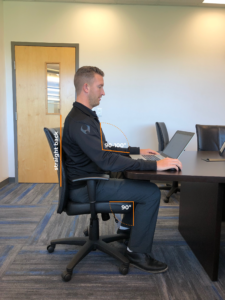
- Sit up with your back straight and your shoulders down and back. Visualize a pole running in a straight line from your head through your spine.
- Distribute your body weight evenly on both hips.
- Bend your knees at a right angle. Your legs should not be crossed.
- Keep your feet flat on the floor. Adjust chair height to allow feel to rest flat on floor.
- Rest your elbows and arms on your chair or desk, keeping your shoulders relaxed.
Stretches/Muscle Release Techniques
Hips flexor stretch with chair: Sitting causes your hip flexors to tighten and shorten which often leads to lower back pain, so it’s important to stretch them out a couple times throughout the day. Adjust your chair so the top of your foot rests on top of the seat while your knee is resting on the floor. Engage your core and glutes and sit up tall avoiding arching your back. Position your knee under the chair to increase the stretch in your hip flexor. Try extending your arms for an added shoulder stretch.
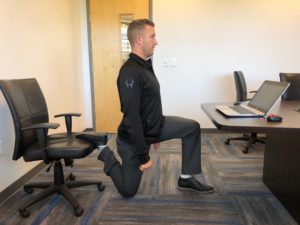
Rotational Spine Stretch: Sit upright in your office chair with your stomach pulled in and shoulders relaxed. With your right hand on the desk, twist your torso to the left, and place your left arm behind the chair back. Breathe deeply and hold for 10 seconds. Perform 3 repetitions on both sides.
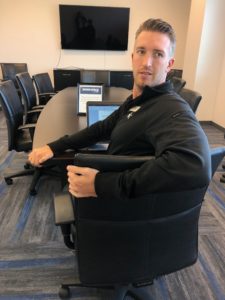
Shoulder Release: Using a ball (tennis ball, baseball, lacrosse ball) press the ball firmly into the top of your shoulder (trapezius). Hold on tender spots for 10-20 seconds or until the muscle loosens.
Latissimus Dorsi Release: Position a ball behind your shoulder blade so it’s on the large muscle running down the side of your back (Latissimus Dorsi). Depending on the height of the back rest of your chair you can lean back to press the ball against the back rest or stand up and press against the wall. Move around the ball to find tight muscles and hold for 10-20 seconds or until the muscle loosens.


Chair Exercises
Briefcase chair squat: Place the office chair to lowest setting. With feet shoulder-width apart, squat until glutes skims the surface of seat, then return to start. Repeat 20 times. Add resistance by holding briefcase, purse or laptop to chest.

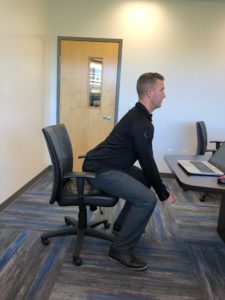
Shoulder blade retraction: Sitting upright in your chair squeeze your shoulder blades together and hold for 10 seconds without hiking your shoulders. Repeat 5-10 times.
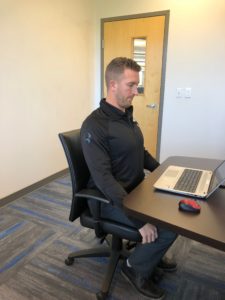
Alternative Options to Chair
Stand Up Desk: There are different types of stand-up desks available. One is a full adjustable desk and the other option (more affordable $100-$200) is one you set on a regular desk and can raise and lower. Both are great options to stretch out your body and get you out of the seated position.
Stability Ball: Using a stability ball as your chair can provide a great alternative option as it requires your core to engage in order to keep your body upright. It also requires proprioceptive (your body’s awareness in space) as your body needs to constantly adjust and readjust to balance on the ball.
Find Your location and Schedule Your Tour Today!

